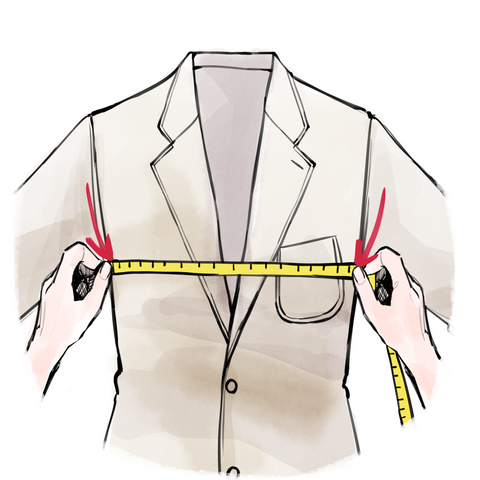How We Measure

With Cathcart's Made to Measure service, it is helpful to know your measurements so that you get the perfect fitting suit. This guide will take you through the most important measurements you can take based on your own body and from your best fitting clothes. All Cathcart suits in our made to measure service have been graded with allowances built in to fit your body.
Height
All suit jackets are cut in proportion to your height. In the Jacket Size section of Made to Measure, you have three choices when choosing your jacket size: Short (5'7 and under), Regular (5'8-6'2) and Long (6'2.5+). Knowing your height, you will select your category whether that is Short, Regular or Long jacket size. Do note that the waistcoat will be cut to your body length once you have made this selection.
Chest Measurement
Let's take your chest measurement. Relax your chest by exhaling and wrap a tape measure around your chest, high up under your armholes with the tape running directly across the nipple points, and record your measurement in inches, as seen below. Make sure you can slide a finger easily in between the tape and your body, ensuring the tape is not too tight. This will serve as your base size (e.g., 40, 42) and from here onward we can get more accurate measurements.

Waist Measurement
Still wearing your waistcoat, relax your stomach and wrap the tape around your high waist directly above the belly button, ensuring the tape is under your last rib and in the soft part of your body, and record your measurement. Make sure you can slide a finger easily in between the tape and you body, ensuring the tape is not too tight. Please record this measurement in CM.
Measuring Clothes
If you have a great fitting jacket possibly from Cathcart, it is useful to know its exact measurements so that you can replicate this in detail with your Made to Measure order. However, please note that the jacket has a built in allowance, enabling the jacket to fit you comfortably. Please record and include this allowance when inputting your measurements having initially selected your chest size (e.g. 40, 42 etc...)
Jacket, chest: Button the jacket closed. Lay the jacket flat and smoothen out all creases. Flip the sleeves up so that the bottom of the armpits are exposed. Measure from armpit to armpit. This measurement will give you the entire half measurement of the jacket that you will see once you select your chest size in the Jacket Size section. Please record this measurement in CM. 

Sleeve length: Measure from the shoulder seam down to the edge of your jacket cuff (wrist bone) as seen below. Please record this measurement in CM.

Jacket, hem: Lay your jacket flat and from the hem, measure across from edge to edge as shown below. Once again our measurements are automatically set to fit you upon selecting your chest size with body height, but please feel free to amend this if would like alternate sizing. Please record this measurement in CM.

Jacket, shoulder: Measure the shoulder width at the widest point between the shoulder seams. Again make sure to fully extend the fabric. Cathcart's house style is a high fitting shoulder, so unless absolutely necessary please consider not changing the set shoulder measurements significantly as they are graded automatically upon selecting your chest/height size.

Trousers, waist width: The very best way to get a great fitting pair of trousers in the waist is to take a pair of trousers that fit you well and simply measure the half waist from seam to seam across the waistband. Measure with the waist buttoned, fully extended and laid flat.
So on the Trousers Size section of Made to Measure, select your trousers size (32, 34, 36 etc.) and check in the Waist Width box the CM measurement that corresponds to the trousers you have just measured. Should you need to increase or decrease the waist, feel free to do so.
NOTE: On vintage garments, the standard sizing requires that the actual garment measurement of the waist exceeds the tagged size by one inch. Example: tagged size 30, actual garment 31" (= 15.5" for the half measurement). The trousers will then hang properly with braces; if worn with a belt they're cinched by that one inch. Most men wearing vintage style trousers prefer the sizing this way, but some prefer a snug fit thus requiring them to size down where possible. So know your own waist size as well as your preferences of fit.
Regarding the rise and the hips, please note that the Cathcart house style is a rise that sits on the belly button and a relaxed comfortable hip. However, should you need to amend the rise or the hips, you can do so on this page also in Edit Advanced Sizes. Please note the hip measurement is taken from 20cm underneath the waistband seam from side seam to side seam.

Trousers, length: Here is where you are going to need to be uniquely specific. Your inseam length is your own and is easily measured to create a perfect fitting length of trouser. Take a great fitting pair of trousers in the leg length and measure from the crotch seam (cross fork) down the inside of the leg to the outer edge of the hem, i.e. the point where your trouser reaches your ankle bone.

Trousers, hem: Cathcart offers two hem width styles, Wide and Straight. Upon selecting trouser style and after your waist measurement, the hem is automatically adjusted to match. However once again we invite you to amend this width according to your personal preferences, but we recommend you stick to our grading as they are based on original 1920s (straight) and 1930s (wide) styles. Simply measure across the hem. Please record this measurement in CM.

If you're still unsure about sizing please feel free to contact us at help@cathcartheritage.com